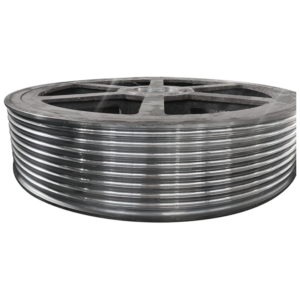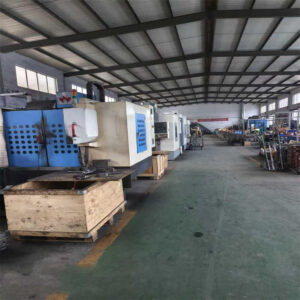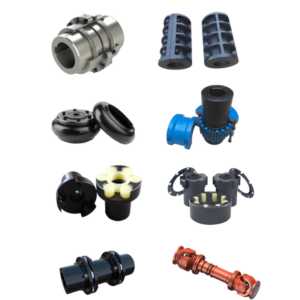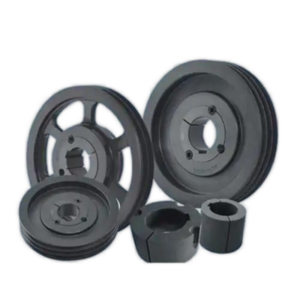Pulleys are essential components in various mechanical systems, facilitating the transfer of power and motion. The choice of pulley material significantly impacts its performance, durability, and suitability for specific applications. This article explores the advantages and disadvantages of several common pulley materials.
Cast Iron Pulleys
Advantages
- High Strength and Durability: Cast iron has excellent mechanical properties, providing high strength and resistance to wear. This makes cast iron pulleys suitable for heavy – duty applications where they can withstand large loads and continuous use without significant deformation.
- Good Damping Properties: Cast iron can absorb vibrations generated during the operation of the pulley system. This helps to reduce noise levels and prevent excessive wear on other components in the system, resulting in a smoother and more stable operation.
- Cost – Effective: Cast iron is a relatively inexpensive material compared to some others. This makes cast iron pulleys an economical choice for many industrial applications, especially when large – scale production is required.
Disadvantages
- Heavy Weight: The high density of cast iron makes the pulleys heavy. This can increase the overall weight of the mechanical system, which may require more energy to operate and can also pose challenges in applications where weight is a critical factor, such as in aerospace or automotive industries.
- Susceptible to Corrosion: Cast iron is prone to rusting when exposed to moisture or corrosive environments. This can reduce the lifespan of the pulley and may require additional protective coatings or maintenance to prevent corrosion.
Steel Pulleys
Advantages
- High Tensile Strength: Steel has a very high tensile strength, allowing steel pulleys to handle extremely high loads. They are commonly used in applications where heavy – duty power transmission is required, such as in large industrial machinery and construction equipment.
- Good Machinability: Steel can be easily machined to achieve precise dimensions and smooth surfaces. This ensures accurate pulley performance and efficient power transfer. Additionally, steel pulleys can be heat – treated to further enhance their hardness and wear resistance.
- Resistant to Impact: Steel pulleys can withstand sudden impacts without significant damage. This makes them suitable for applications where the pulley may be subject to shock loads, such as in mining or forestry equipment.
Disadvantages
- Higher Cost: Compared to cast iron, steel is generally more expensive. The cost of raw materials and the manufacturing processes involved in producing steel pulleys can be relatively high, which may limit their use in cost – sensitive applications.
- Corrosion Risk: Similar to cast iron, steel is also susceptible to corrosion. Although stainless steel can be used to mitigate this issue, it is even more expensive than regular steel.
Aluminum Pulleys
Advantages
- Light Weight: Aluminum has a low density, making aluminum pulleys much lighter than those made of cast iron or steel. This reduces the overall weight of the mechanical system, which can lead to energy savings and improved performance, especially in applications where weight reduction is crucial, such as in aircraft and high – speed machinery.
- Good Corrosion Resistance: Aluminum forms a natural oxide layer on its surface, which provides a certain degree of protection against corrosion. This makes aluminum pulleys suitable for use in outdoor or humid environments without the need for extensive protective coatings.
- High Thermal Conductivity: Aluminum has good thermal conductivity, which allows it to dissipate heat generated during operation more effectively. This can help to prevent overheating of the pulley and other components in the system, extending their service life.
Disadvantages
- Lower Strength: Compared to cast iron and steel, aluminum has lower strength. This limits the use of aluminum pulleys in applications where high loads are involved. They are typically used in lighter – duty applications, such as in small – scale machinery and automotive accessory drives.
- Higher Cost per Unit Strength: Although aluminum is generally less expensive than some high – performance steels, when considering the strength – to – cost ratio, it may be less cost – effective for heavy – duty applications.
Plastic Pulleys
Advantages
- Low Cost: Plastic is a relatively inexpensive material, and the manufacturing processes for plastic pulleys are often simple and cost – effective. This makes plastic pulleys an attractive option for low – cost applications, such as in consumer products and light – duty industrial equipment.
- Light Weight: Similar to aluminum pulleys, plastic pulleys are very light, which can contribute to energy savings and ease of installation.
- Corrosion and Chemical Resistance: Plastic is highly resistant to corrosion and many chemicals. This makes plastic pulleys suitable for use in harsh chemical environments where metal pulleys would quickly deteriorate.
Disadvantages
- Low Strength and Durability: Plastic has lower strength and wear resistance compared to metals. Plastic pulleys are not suitable for heavy – duty applications or those involving high – speed and high – load conditions. They may deform or break under excessive stress.
- Poor Heat Resistance: Most plastics have limited heat resistance. In applications where the pulley generates a significant amount of heat during operation, plastic pulleys may melt or lose their shape, leading to system failure.
In conclusion, the choice of pulley material depends on a variety of factors, including the specific application requirements, load capacity, operating environment, and cost considerations. Each material has its own unique set of advantages and disadvantages, and a careful evaluation is necessary to select the most appropriate material for a given pulley system.







